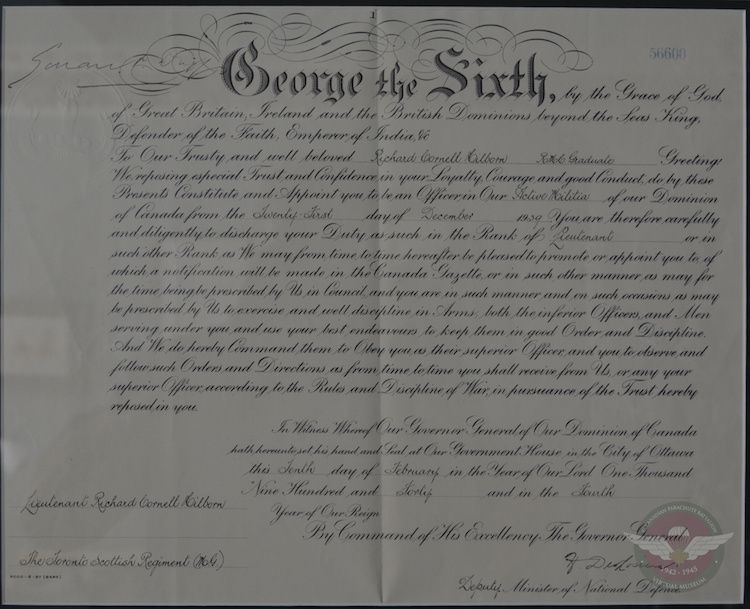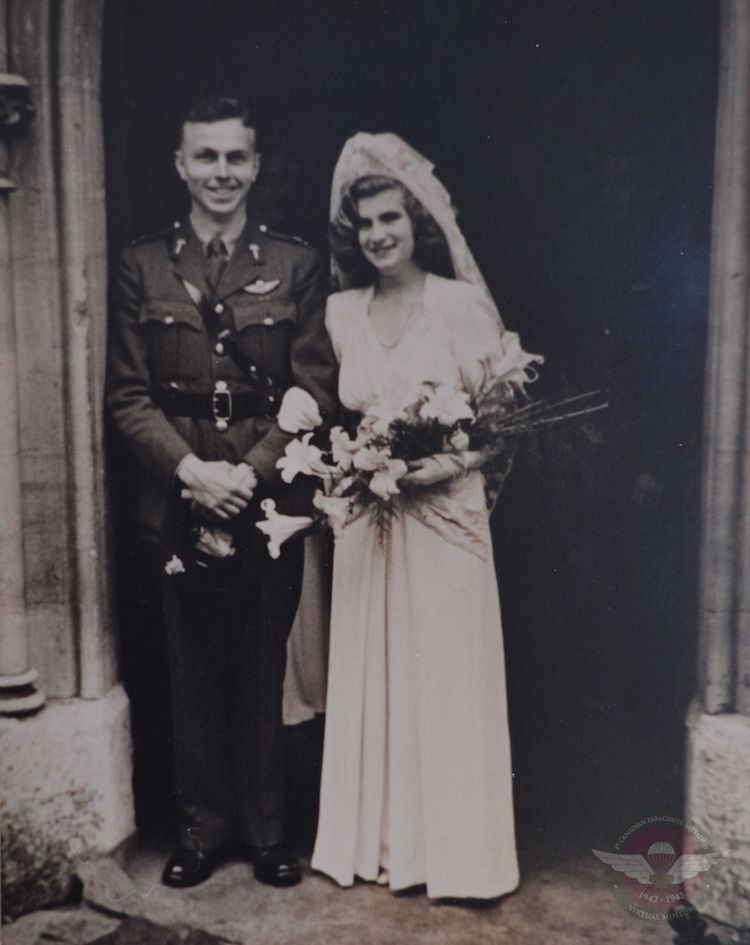Major Richard Cornell Hilborn, MiD
Major Hilborn was born May 10, 1918 in Preston, Ontario and was the second child of four. He was accepted into the Royal Military College (R.M.C.) in Kingston, Ontario on September 4, 1937. He attended the Militia camp during the summer as a 2nd Lieutenant attached to the Highland Light Infantry. When the war broke out, Hilborn left R.M.C. on December 20, 1939, reported to the Military District #2 (Toronto) and joined the Toronto Scottish Regiment. He had not yet completed his degree but promised himself he would do so as soon as the war was over. He was taken on strength with the Machine Gun Training Centre on January 1, 1940 and later qualified as Mortarman.
Hilborn had two friends named Clayton Fuller and Donny Wilkins who both suggested he transfer to the 1st Canadian Parachute Battalion. Later, he met Jeff Nicklin and Fraser Eadie, who convinced him Airborne was the way to go. By this time, Hilborn was a Major with the Toronto Scottish and like many of the officers transferring to the 1st Canadian Parachute Battalion he accepted a reduction in rank and became a platoon commander. Reduction in rank was not an uncommon practice for men joining the Battalion. Hilborn proudly graduated from his Parachute course at Ringway, UK on April 13, 1944 and started receiving parachutist pay immediately thereafter.
It didn’t take long before Hilborn was promoted to the rank of Major once again when he became Commanding Officer of Headquarters Company. He enjoyed that role in Headquarters Company which also included the heavy-weapons platoons. His previous experience with mortars, machineguns and Bangalore torpedoes in the Toronto Scottish made him a good fit for the job.
Hilborn parachuted into Normandy during Operation Overlord on June 6, 1944 as part of Headquarters Company. He also parachuted into Germany during Operation Varsity on March 24, 1945, and also served in Belgium and Holland. He saw much action while overseas and received an MiD (Mentioned in Dispatches) along with a field promotion, making him the 2IC (2nd in Command) of the Battalion.
While serving in the UK, he met a young attractive girl named Laurette Parsons. They fell in love, were engaged on May 26, 1945 and married very shortly after on June 6, 1945. Laurette came from a military family; her father served in the First World War and her brother, Norman, was a naval aviator in the Fleet Air Arm of the Royal Navy. Norman’s war ended when his Fairey Swordfish torpedo bomber was shot down over the North Sea one week before his 21st birthday.
Laurette moved to Canada from the UK to start her new life with Richard in November, 1945. Her parents moved to Canada in 1951 and her father went to work for A.V. Roe in Malton, Ontario where he became one of the engineers who designed and built the ill-fated Avro Arrow.
Hilborn had made many close friends during the war, including Brigadier General James Hill. They remained good friends long after the war. General Hill even attended Richard and Laurette’s wedding. When it appeared that Richard and Laurette had difficulty finding a place to stay after getting married, James Hill’s mother kindly offered the newlyweds her home.
When the war was finally over for Hilborn he was fortunate enough to return back to civilian life without a scratch. He participated in all the parachute operations and major battles with the Battalion and escaped harm from enemy gunfire and bombs. He was one of the lucky few who made it home without any serious injuries. Hilborn worked for his father at the furniture production company where he proved to be an asset. He and Laurette produced four beautiful children, two boys and two girls.
In November 1983, Hilborn went with a group of friends to a hunting camp on Griffith’s Island in Georgian Bay, Ontario. During the trip, one of the fellows accidentally discharged his shotgun and Hilborn took the full blast into his lower right leg at close range. He said that at the time, the traumatic experience instantly brought him back to Normandy where he witnessed many of his men die and or become seriously injured during battle. Several hours later, after finally being transported to the hospital, Hilborn’s leg could not be saved, leaving amputation the only option. It’s hard to imagine how this brave man managed to escape harm during the war, only to be accidentally shot by a friend during a time of peace.
Hilborn had a long overdue goal in mind that needed tending to. The war had pulled him away from his studies at the Royal Military College and he had promised himself he would complete his degree once the war was over. He picked up where he left off with his education and graduated with a Bachelor in Military Science from R.M.C. on May 19, 1994. This was another extremely proud day for him.
Hilborn died peacefully on February 21, 2006 at the age of 87 and is interred at the family plot in Preston (Cambridge). He was the last surviving officer of 1 Can Para who served in every one of the battalion’s campaigns.
Photographs and unique items courtesy of Laurette Hilborn. Thank you to Michael Hilborn for additional biographical information.






















